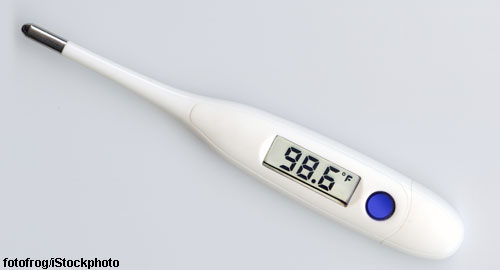 Like many other physicians, Jonathan S. Hausmann, MD, a pediatric and adult rheumatologist at Boston Children’s Hospital and Beth Israel Deaconess Medical Center, both in Boston, finds that determining a fever’s underlying cause can be challenging. Patients may develop fevers for many reasons, including infection, malignancy or an underlying rheumatic condition, such as lupus, rheumatoid arthritis or vasculitis.
Like many other physicians, Jonathan S. Hausmann, MD, a pediatric and adult rheumatologist at Boston Children’s Hospital and Beth Israel Deaconess Medical Center, both in Boston, finds that determining a fever’s underlying cause can be challenging. Patients may develop fevers for many reasons, including infection, malignancy or an underlying rheumatic condition, such as lupus, rheumatoid arthritis or vasculitis.
While reading the medical literature to identify better ways of using fever for diagnosis, Dr. Hausmann was surprised to find large gaps in the basic understanding of temperatures in the human body. For example, the notion that a normal body temperature is 98.6° F and a fever is 100.4° F was derived from a single study performed in the 1860s using an ancient thermometer.1 More current studies have attempted to replicate this study and found that average body temperatures are actually lower. However, these studies were also small and did not include diverse populations.
“Improved understanding of temperature is important because physicians often decide whether or not to admit a patient to the hospital, or how to treat them, based solely on a patient’s temperature,” Dr. Hausmann says.
To improve the understanding of body temperatures in health and disease, Dr. Hausmann is attempting to replicate the original fever study, while leveraging modern technology and social media in a project called Feverprints.
Research Begins
To conduct his study, Dr. Hausmann used Apple’s research platform, ResearchKit, to create an iPhone app in conjunction with the Innovation and Digital Health Accelerator team at Boston Children’s Hospital, which is sponsoring the study along with Beth Israel Deaconess Medical Center. The app became available in April 2016. Any adult or child—whether they are healthy or have a chronic condition—can participate in the study. Unlike traditional studies in which physicians decide who can participate, patients are empowered to enroll themselves in the study.
Feverprints has several goals—beginning with obtaining a better understanding of what normal body temperatures are in different segments of the population at different times of the day. He also wants to obtain what he calls a feverprint (like a fingerprint) of various febrile illnesses to help diagnose patients solely on their illness’ fever pattern. He thinks the pattern of fevers in patients with different conditions may vary, and that he may be able to identify and use these fever patterns for rapid, accurate diagnosis and to provide more timely treatment.
Further, he wants to study the effects of antipyretics, such as ibuprofen and acetaminophen, on febrile illnesses. “Any patient who is admitted to the hospital with a fever is automatically given one of these medications,” Dr. Hausmann says. “Fever is part of the body’s natural response to infection. Some studies suggest that treating a fever with antipyretics impairs the immune system’s ability to fight an infection, and therefore, it may prolong the illness.”2,3
How It Works
Participants need to have an iPhone or iPad to download the Feverprints app, which is available in Apple’s App Store. After signing a consent form, participants are asked to provide information about their medical history, medications, family history and lifestyle habits (e.g., smoking, drinking and amount of exercise). Participants regularly log their temperatures, symptoms and medications taken for fever. Participants can measure their temperatures with a standard thermometer and manually enter their temperature in the app. Those with Bluetooth-enabled thermometers can automatically import their temperatures into the Feverprints app.
The study is completely anonymous; researchers do not know participants’ identities, and no protected health information is shared. So far, more than 1,000 participants have contributed data.
“We have intriguing preliminary data suggesting that 98.6° F is not the average temperature for the human body,” Dr. Hausmann reports.
The Outlook
Dr. Hausmann admits that it’s a lofty goal to predict underlying illness by solely looking at temperature patterns from crowd-sourced data, but he’s confident that he can achieve it.
“After one year, I think we will have enough data to determine normal temperatures for people of various ages and genders. But being able to predict an illness solely based on its fever pattern will take longer,” he says. He’s also optimistic that the study will identify the effects of antipyretics—whether good or bad—on febrile diseases.
Dr. Hausmann also hopes patients will benefit from directly enrolling in the study by obtaining a better understanding of their conditions and symptoms, as well as how medications affect them. Participants will also be able to share their data with physicians, which may help improve their own medical care.
Karen Appold is a medical writer in Pennsylvania.
References
- Wunderlich CA. On the temperature in diseases: Medical thermometry. London: The New Sydeham Society. 1871.
- Doran TF, De Angelis C, Baumgardner RA, Mellits ED. Acetaminophen: More harm than good for chickenpox? J Pediatrics. 1989 Jun;114(6):1045–1048.
- Graham NMH, Burrell CJ, Douglas RM, et al. Adverse effects of aspirin, acetaminophen, and ibuprofen on immune function, viral shedding and clinical status in rhinovirus-infected volunteers. J Infect Dis. 1990 Dec;162(6):1277–1282.


